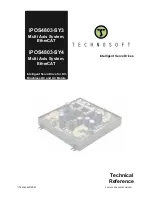
142
Learning Advanced Features
Advanced Tasks
Description
Ref.
Auto restart
operation
Auto restart configuration is used to automatically restart the
inverter when a trip condition is released, after the inverter
stops operating due to activation of protective devices (fault
trips).
Second motor
operation
Used to switch equipment operation by connecting two motors
to one inverter. Configure and operate the second motor using
the terminal input defined for the second motor operation.
Commercial power
source switch
operation
Used to switch the power source to the motor from the inverter
output to a commercial power source, or vice versa.
Cooling fan control
Used to control the cooling fan of the inverter.
Multi-function
output On/Off
control
Set standard values and turn On/Off the output relays or multi-
function output terminals according to the analog input value.
Regeneration
prevention for
press operation.
Used during a press operation to avoid motor regeneration, by
increasing the motor operation speed.
Damper operation
Controls the fan motor optimally when a damper is used in the
system.
Lubrication
operation
Supplies lubricant to the machinery before starting the inverter
and the mechanical system connected to it.
Flow
compensation
Compensates for pressure loss in a system with long pipelines.
Energy savings
display
Displays the amount of energy saved by the use of the inverter,
compared to when a commercial power source is used without
an inverter.
Pump clean
operation
Cleans the pumps by removing the scales or deposits that are
attached to the impeller.
Inclination setting
for operation and
stop
Sets the initial operating conditions for a pump by adjusting the
acceleration and deceleration times.
Valve deceleration
time setting
Prevents possible pump damage that may be caused by
abrupt deceleration.
Load tuning
Creates load-specific curves for light load operations and the
pump clean operation.
Level detection
Detects and displays the level set by the user.
Pipe breakage
detection
Detects breakages in the pipeline during a PID operation.
Motor preheating
Prevents motors and pumps from freezing when they are not
operated.
Scheduled
operation
Uses the built-in real-time clock (RTC) to operate the inverter
according to the desired time schedule.
Fire mode
operation
Operates the inverter in a way to cope with emergency
situations, such as fire, by controlling the operation of
ventilation (intake and exhaust) fans.
Summary of Contents for LSLV-H100 Series
Page 17: ...Preparing the Installation 4 37 90 kW 3 Phase ...
Page 18: ...Preparing the Installation 5 110 132 kW 3 Phase ...
Page 19: ...Preparing the Installation 6 160 185 kW 3 Phase ...
Page 20: ...Preparing the Installation 7 220 250 kW 3 Phase ...
Page 21: ...Preparing the Installation 8 315 400 kW 3 Phase ...
Page 22: ...Preparing the Installation 9 500 kW 3 Phase ...
Page 35: ...Installing the Inverter 22 ...
Page 50: ...37 Installing the Inverter Input and Output Control Terminal Block Wiring Diagram ...
Page 104: ...91 Learning Basic Features 0 10 V Input Voltage Setting Details V1 Quantizing ...
Page 181: ...168 Learning Advanced Features PID Command Block ...
Page 182: ...169 Learning Advanced Features ...
Page 183: ...170 Learning Advanced Features PID Feedback Block ...
Page 184: ...171 Learning Advanced Features PID Output Block ...
Page 185: ...172 Learning Advanced Features PID Output Mode Block ...
Page 198: ...185 Learning Advanced Features EPID1 Control block ...
Page 199: ...186 Learning Advanced Features EPID2 Control block ...
Page 220: ...207 Learning Advanced Features ...
Page 235: ...222 Learning Advanced Features The Time Chart for the Exception Day ...
Page 506: ...Table of Functions 493 ...
Page 520: ...Table of Functions 507 8 16 4 Cooling Tower MC4 Group ...
Page 549: ...Troubleshooting 536 ...
Page 569: ...Technical Specification 556 11 3 External Dimensions 0 75 30 kW 3 phase 37 90 kW 3 phase ...
Page 570: ...Technical Specification 557 110 185 kW 3 phase ...
Page 601: ...588 ...
Page 602: ...589 ...
Page 603: ...590 ...
















































